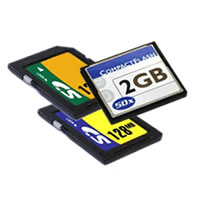CAUSES |
SOLUTIONS |
Removing your memory card from the camera or turning the camera off while the file is still being written to the memory card. |
Check that the warning light/screen message has turned off, indicating the data transfer is complete, before removing your memory card. |
Removing the memory card while the camera is still turned on. |
Always ensure you turn the camera off and allow time for it to close down before you remove the card. |
Using weak batteries to operate a digital camera. |
Always put fresh batteries into your camera before going out to take pictures to avoid automatic camera shutdowns. When the batteries get low, replace them with fresh batteries so that your camera always has enough power to write the information to your card. |
Exposing the memory card to a heavy static charge or strong magnetic field, such as the new, high-density airport X-ray machines. |
Store your memory cards in a protective case or wallet and always take them with you as hand luggage when travelling. Walk-through X-ray machines are safer than those used for checked luggage. |
Damaged or dirty contacts due to improper card storage. |
Store your cards carefully when not in use, in their protective plastic cases or purchase inexpensive storage cases. |
Removing the card from a card reader while you still have open files from the card on your computer, or while the copying process is still underway from the card to the computer. |
Remove your card from the card reader only after the card has stopped communicating with your computer, the activity light has stopped blinking and all files are closed. |
Using a card that has been reused several times without first reformatting it in your camera. |
Get into a regular habit of transferring your images to a storage device, such as a DVD/CD and then formatting your card (usually in Setup mode of your camera), rather than adding and deleting images all the time. |
Formatting your card in the computer, rather than in your camera. |
This confuses your camera and it can lose track of your files. If you have to do this, immediately reformat the card once it is back in your camera. |
When the card in your camera is close to being filled to its maximum capacity, or is completely full, engaging in a pattern of deleting files, shooting more images and then deleting more files. |
Stay aware of how full your card is, wait to edit and delete files until after you have copied them to your computer/storage device. Deleting one or two images will probably be ok but once cards become to full, they can overwrite some of the card headers and file formats. |
Swapping the same memory card between different devices or cameras |
Once again this will cause the camera to become confused and therefore corrupt. Try to keep the cards for each device separate or format them in each different device they are used in. |


 We all agree that digital cameras and their memory cards are one of the best inventions since sliced bread - that is until something goes wrong.
We all agree that digital cameras and their memory cards are one of the best inventions since sliced bread - that is until something goes wrong.